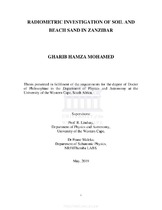Radiometric investigation of soil and beach sand in Zanzibar
Abstract
This study presents the results of radiometric investigation of soil and beach sand in Zanzibar. The activity concentration of natural radionuclides (40K, and 232Th and 238U decay products) in beach sand and soil samples was measured in-situ using the NaI(Tl) and the MEDUSA gamma ray detectors and ex-situ using the low background HPGe detector system.
The activity concentrations of 232Th, 238U and 40 K in beach sand are much lower than in soil samples, with one major exception at Kukuu. Two beach sand samples from Kukuu beach were found to have enhanced radioactivity levels due to the presence of heavy minerals.
The spatial distributions maps for 40K, 238U and 232Th show large variation in soil samples for two relatively small islands. These strong variations are unexpected, that could have implications for agriculture, is one of the major outcomes of this study.
The outdoor gamma dose rates obtained in beach sand and soil samples ranged from 3 to 2156 nGy h-1 and 50 to 294 nGy h-1, respectively. The highest absorbed dose rates in soil samples and beach sand are respectively 5 and 38 times higher than the average world level of 57 nGyh-1 for terrestrial doses (UNSCEAR, 2008). Apart from the Kukuu black sand samples that contain the high 238U and 232Th levels, the beach sands and soil in this study do not pose any radiological threat to the public using beaches for various activities.
Based on elemental concentrations, the beach samples in the study area have been classified into four groups; silicate sand (rich in SiO2), carbonate sand (dominated with CaO), mixed sand (with high amount of CaO and SiO2) and heavy mineral sand (with high contents of Fe2O3 and TiO2.
A strong correlation between SiO2, Fe2O3, TiO2, Zr, V, Ce, Nb, Hf, Y, La, and Nd show these elements are linked with high activity concentration of 232Th in the studied samples. Moreover, the high concentrations of Y, V, P2O5 and Fe2O3 in the beach sand samples may relate to high 238U activity concentration.
This study set out to investigate how radiometric studies can quickly and easily provide an idea of the variation of soil type found over a large area as well as provide detailed information on a small scale such as the beach where heavy minerals were found. The in-situ laboratory measurements were supplemented by XRF and ICP-MS measurements of samples to investigate the distribution of heavy mineral sands.

